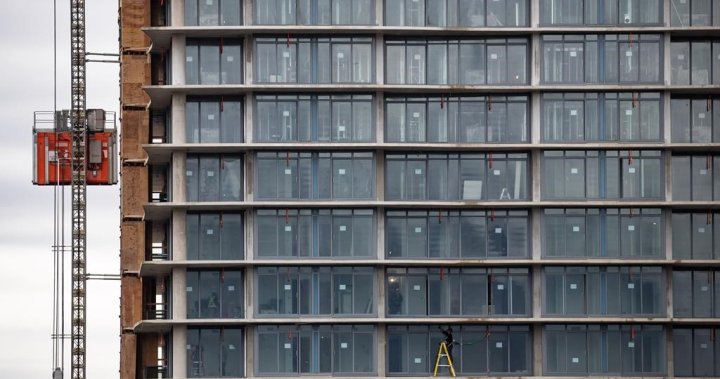How Trump’s tariffs could hurt Canada’s home construction industry – National

With the threat of tariffs still looming from the U.S., homebuilders in Canada are warning that the uncertainty could impact construction at a time when people are struggling to get into the market.
Earlier this week, the Canada Mortgage and Housing Corp. (CMHC) released its housing starts report for January, which showed the annual pace had risen by three per cent since last year.
But tariffs could pose an issue — in particular, around two “major concerns.”
“One is: how this is going to impact inflation on goods that are consumed by people in Canada and also, what are the consequences on the labour market?” CMHC deputy chief economist Kevin Hughes said.
“Then as a consequence of that, how would the housing market, or let’s say supply and demand, be impacted by that?”
He noted there will be a potential shock to the economy if tariffs are imposed, but it depends on the specifics of what is implemented.
His comments echo similar remarks by fellow CMHC deputy chief economist Tania Bourassa-Ochoa, who wrote in Monday’s housing starts report that trade risks pose “significant uncertainty” for the market.
Fewer sales can mean less construction
The initial impact, however, may be less on materials used in construction and more on the economy.
“If we end up with some sort of economic downturn as a result [of tariffs], that invariably leads to less sales and less housing starts at a time when we need more housing starts,” Canadian Home Builders’ Association CEO Kevin Lee said.
“Slowdowns in sales leads to slowdowns in starts.”

Get daily National news
Get the day’s top news, political, economic, and current affairs headlines, delivered to your inbox once a day.
Unlike in 2022, when housing was being sold at record paces, the market has slowed considerably following a number of interest rate hikes by the Bank of Canada.
That’s left a larger inventory of houses available for buyers.

That can leave builders questioning whether to build more in a time of uncertainty, said Scott Andison, CEO of the Ontario Home Builders’ Association.
He said a builder takes risks when taking on a housing project with financing, sourcing materials, putting together staff, and determining costs and then interest from the public.
“You’re trying to predict how many people are going to be stepping up to buy those homes you’re building, and builders need predictability and they need stability when it comes to these projects,” he said.
Canada is seeing a buyer’s market right now because of lower interest rates, but the looming tariffs could put some Canadians off from buying, according to Clay Jarvis, NerdWallet’s housing expert.
“If you have something like these tariffs and any sort of associated job losses, that might be a part of it that’s just going to put another dent into the demand for the new build,” he said.
“So if you’re a builder, are you going to commit to a project, are you going to charge your buyers a lot more money at a time when they’re not interested in buying your product anyway?”
Building materials could see prices rise
The two countries’ integrated supply chains mean products and materials cross the border several times during manufacturing processes, and would face that U.S. tax.
But if Canada imposes retaliatory tariffs on products like appliances, something often used in highrises and condos and that Prime Minister Justin Trudeau initially planned to include in tariffs, then the costs will increase even more.
“Probably going to be more expensive because we’re probably buying them from the States for good reason,” he said. “So it has all kinds of opportunity to disrupt the supply chains.”
Steel and aluminum currently face a 25 per cent tariff set to come into place March 12, and Andison told Global News such a tariff means the product becomes less attractive to U.S. markets.
This then can cause the price to go up domestically per unit because not as much is being sold.

“All of a sudden that makes domestic product available for homebuilders in Ontario more expensive to buy domestically,” he said.
As the industry faces threats from the tariffs, both Lee and Andison said more action needs to be done by governments to lessen costs homebuilders face, such as fees and taxes.
In Ontario, Andison said 30 to 33 per cent of the cost of the home is made up of government fees and taxes. Lee said breaking down trade barriers between provinces so that more domestic products can be procured without issue would also have a big impact.
“It should not be easier to move product north and south than east [and] west,” Lee said.
© 2025 Global News, a division of Corus Entertainment Inc.








